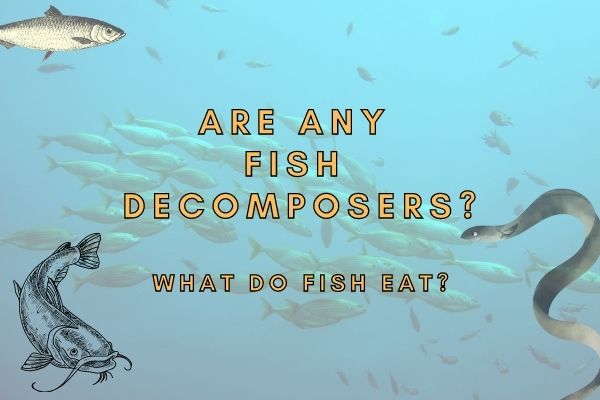Fish are a type of vertebrate that live in water. They come in all shapes and sizes, and can be found in every corner of the world. Fish are either omnivores, carnivores or herbivores depending on the species, but some may also be considered scavengers.
Fish are not decomposers because they eat other living organisms to survive and are therefore considered to be consumers. Some fish, like eels, hagfish and catfish are scavengers of the ocean but are not actual decomposers like fungi and bacteria.
Fish live in water. They can be found in ponds, rivers, oceans, and streams. Fish are everything from carnivores, herbivores, or omnivores depending on the species. Fish are important to the ecosystem because they eat algae, shrimp, mollusks, and other small fish.
Omnivorous fish will eat both plants and animals, while carnivorous fish will only eat other animals. Herbivorous fish will only eat plants. Some common food items that fish eat include algae, shrimp, mollusks and small invertebrates.
Can Fish be Considered Decomposers?
No, fish are generally not decomposers because they mostly eat living organisms. However, many other animals and bacteria in the ocean are decomposers, which mean that they break down dead organisms. They may, however, eat the animals and bacteria that are part of decomposing dead organisms.
However, some fish are considered scavengers because they, like vultures on land, eat the leftovers of dead animals in the ocean.
However, scavenger fish are extremely important for the ecosystem because they play a critical role in the food chain. They are omnivores and scavengers, which means they consume both plant and animal matter.
This helps to keep the ecosystem balanced by controlling populations of both plants and animals. In addition, fish waste provides nutrients that help to fertilize the water and promote growth of aquatic plants.
Fish also serve as a key source of food for many animals in the wild, including humans. In fact, fish are one of the most popular types of seafood consumed by people all over the world.
Not only do they provide a delicious source of protein, but fish are also low in fat and calories, making them a healthy option for many people.
What Fish are Scavengers?
There are many different types of scavenging fish, but some of the most common include catfish, hagfish, and eels. These fish typically have a long body and large mouth that can help them eat a wide variety of things.
These scavenging fish are not considered decomposers, because they are actually not the last step in the nutrient cycle – the bacteria in their digestive systems are!
Scavenger fish are a type of fish that feed on other creatures that have died. They typically eat things like dead animals, plant debris, and even other fish.
Some scavengers are very specialized in what they eat and can be found only eating certain types of carrion, but most of them are not picky eaters!
The most important scavenging fish are:
- Catfish
- Sharks
- Hagfish
- Lampreys
- Remoras
- Eels
- Eelpouts
If you want to read more these and other examples, check out my much more elaborate article about scavenger fish here!
Some scavengers are important to the ecosystem because they help keep things in balance. For example, if there are too many dead animals, scavengers will start to eat them and eventually the food chain will be disrupted.
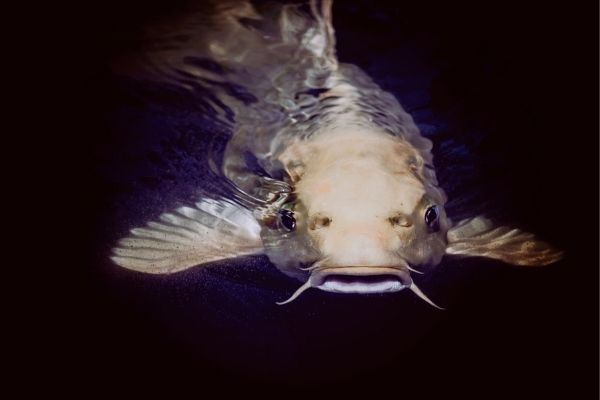
Scavengers are important to the ecosystem because they help keep things in balance by eating dead animals and plant debris.
Primary Diet of the Fish
Most fish are carnivores, herbivores, or omnivores. Some fish eat algae, while other fish eat shrimp and mollusks. Some fish are omnivorous, and will eat both algae and shrimp.
Some of the most common food items eaten by fish are:
- Plankton (Zoo- and phytoplankton)
- Algae
- Seaweed
- Shrimp
- Lobsters
- Snails
- Crabs
- Mussels
- Oysters
- Crawfish
- Eels
- Smaller fish
- Clams
- Krill
Most fish have teeth that are used to grasp prey. Most fish swallow their prey whole. Fish have a simple digestive system, which absorbs the nutrients from their prey in a similar manner to most mammals.
Are Fish Carnivores, Herbivores or Omnivores?
Fish are a very diverse group of animals, and while some are carnivores, many are omnivores. Carnivores eat only other animals, while omnivores eat both plants and animals. This again depends on the species and the fish’s habitat.
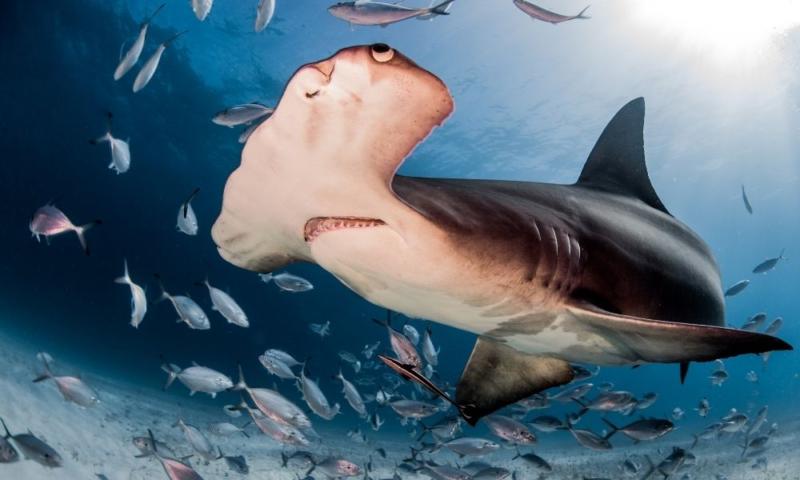
But as you can read much more about on this blog, sharks can also be decomposers!
Is a Fish a Producer or Consumer then?
Fish are consumers because they eat other living things. Some species of fish are carnivores, which means they only eat other animals, while other species of fish are omnivores, which means they eat both plants and animals. No fish are actual producers, only plants and microorganisms are. With a few exceptions!
Are Fish Autotrophs or Heterotrophs?
All fish are heterotrophs because they eat other living organisms. Practically no animals are autotrophic because animals do not get their energy directly from the sun like plants do. But there are few exceptions!
That is, animals like the fish cannot make their own energy, but need to eat other organisms as their energy and carbon source.
What Type of Consumer is a Fish?
Fish that are herbivores are primary consumers, omnivore fish are generally secondary consumers and carnivores fish are tertiary consumers.
Many fish are omnivores because they eat both plants and animals. In that case, their consumer level is defined by the “highest” animal in the food chain that they have as prey.
Where are Fish in the Food Chain?
Fish are very diverse and occupy a variety of places in the food chain depending on their consumer status.
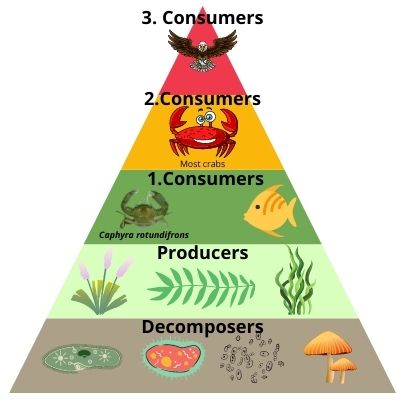
Some species of fish are herbivores, which mean they eat only plants, while others eat both plants and animals and are considered omnivores. Purely carnivorous fish, like sharks, are apex predators placed in the very top of the food chain!
Again, the exact placement in the energy pyramid depends on the species and the fish’s habitat.
What Animals Prey on Fish?
Fish are most often hunted and eaten by larger fish and mammals that live in or around water. Some large species of fish are eaten by sharks, dolphins, seals and sea lions. But also by crabs, shrimp, crayfish, octopi, squids, jellyfish and even sea anemones eat fish!
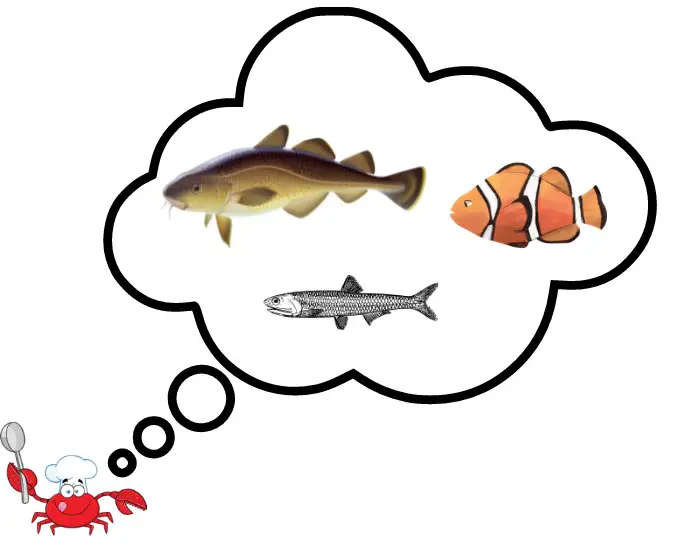
But fish are also eaten by for example birds and reptiles including eagles, herons, crocodiles and snakes.
Some parasites also eat fish. The parasites that live inside fish are called endoparasites.
Parasites are organisms that live off or on other animals. Some parasites are large, such as tapeworms. Others are microscopic. Parasites come in all shapes and sizes.
An endoparasite lives in a fish’s intestines. Some endoparasites attach to the fish’s organs and tissues. This causes internal damage. Endoparasites can also cause infections. An endoparasite cannot live without a fish host. So, the parasite must rely on its host for food.
A tapeworm, for example, uses its powerful muscles to attach to the fish. The tapeworm then grows and consumes the fish’s blood. The tapeworm eventually grows large enough to be visible.
Conclusion
In this post, I have looked into the fish diet and the different types of fish that find their homes in UK waters.
We have looked into fish habitat, their food sources and the different types of fish that can be found in our waters.
Whereas no fish are actual decomposers, many are scavengers, which I have written a whole article about!
The diet of fish is important to understand because it can be a big influence on the ecosystem that fish live in. Some fish can be considered omnivores and others are carnivores or herbivores.
The differences in the diets and habits of fish are shown when you look at the size of the fish – bigger fish eat bigger food, and smaller fish eat smaller food.
However, bigger fish (and sometimes bigger predators) can have more diverse diets as they have more room to roam.
Fishes are interesting animals as their body shapes and diets vary substantially!
Fishes are the only group of vertebrates with fins that are modified into independent swimming appendages.
There was a time when fish only had one fin resembling something that looked like a modern tadpole!
Fins are decedents of these creatures, evolved in the Devonian Period over 500 million years ago.
I hope you enjoyed this blog post on the diet of fish and how they are at the heart of the marine ecosystems!

